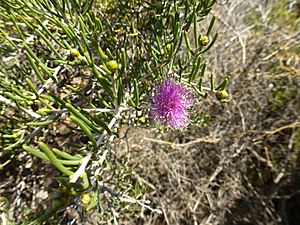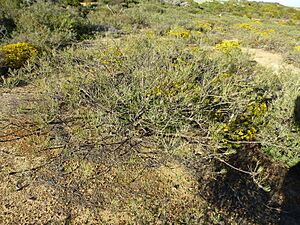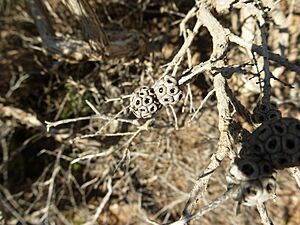Wiry honey-myrtle facts for kids
Quick facts for kids Wiry honey-myrtle |
|
|---|---|
 |
|
| Melaleuca filifolia leaves and flowers | |
| Scientific classification | |
| Genus: |
Melaleuca
|
| Species: |
filifolia
|
The Melaleuca filifolia, also known as the wiry honey-myrtle, is a special plant. It belongs to the myrtle family called Myrtaceae. This plant is found only in the south-west part of Western Australia. It's a woody, bushy shrub with thin, needle-like leaves. Its flowers look like pink "pom-poms" and its fruits are round clusters.
Contents
What Does It Look Like?
The wiry honey-myrtle is usually a small, spreading shrub. It can grow up to 2 m (7 ft) tall. Sometimes, it can even reach 4 m (10 ft) in height.
Leaves and Stems
Its leaves grow one after another along the stem. They are shaped like a circle if you cut them across. Each leaf is about 10–35 mm (0.4–1 in) long. They are also quite thin, around 2–4 mm (0.08–0.2 in) wide. The plant has many thin, twiggy branches.
Flowers and Fruits
The flowers of the wiry honey-myrtle grow in round clusters. These clusters can be up to 23 mm (0.9 in) across. You'll find these flower heads at the ends of branches. New growth often appears from these branches even after the flowers bloom. Sometimes, flowers also grow where the leaves meet the stem.
Each flower cluster has 6 to 13 groups of three flowers. The small petals are about 1.7–2.5 mm (0.07–0.1 in) long. They fall off as the flower opens up. The stamens are the parts that hold pollen. They are purple, pink, or mauve with shiny golden tips. These stamens are grouped into five bundles around the flower. Each bundle has 7 to 11 stamens.

The plant usually flowers in late spring to summer. After the flowers, it produces woody capsules. These are like small, hard seed pods. They grow in tight, almost round clusters. These fruit clusters can be up to 14 mm (0.6 in) wide. They look a bit like tiny footballs!
How It Got Its Name
The Melaleuca filifolia was first officially described in 1862. This was done by a scientist named Ferdinand von Mueller. He wrote about it in his book Fragmenta Phytographiae Australiae. He found a sample of the plant in the dry bed of the Murchison River. This sample was collected by Augustus Oldfield.
The second part of its scientific name, filifolia, comes from two Latin words. Filum means "filament" or "thread." Folium means "leaf." So, filifolia describes its thin, thread-like leaves.
Where Does It Grow?
This type of melaleuca plant grows in Western Australia. You can find it between the Kalbarri and Mullewa areas. These places are near Geraldton. It lives in different types of land, including sandy, gravelly, and loamy soil. It often grows over sandstone in areas called Kwongan or tall scrub.
Is It Safe?
The Melaleuca filifolia is currently listed as "not threatened." This means it is not in danger of disappearing. The Government of Western Australia's Department of Parks and Wildlife keeps track of its status.
Growing It in Gardens
Some people like to grow certain types of this plant in their gardens. It can be a nice addition to a home garden.
Related Plants
- Melaleuca nematophylla, which is also known as the wiry honey-myrtle.


